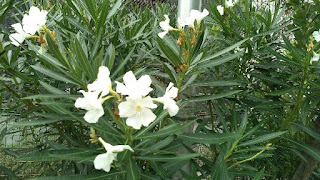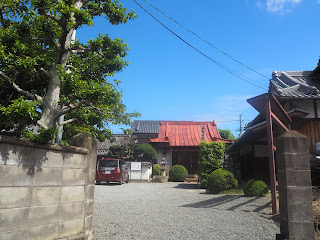Zensho-ji Temple was founded by Priest Keizan (?-1461) in 1428.
In ancient times, there used to be the Musashi Seven Corps. The most part of Musashi Province was plateaus deeply covered with volcanic-ash soil, which was suitable for stock farming, not for rice growing. In ancient times, many of the naturalized Silla people then were sent to Musashi Province, and engaged in the stock farming. That stimulated local people there, and many stock farms were set up, including 6 imperial stock farms. The custodians of those farms later formed small-scale would-be-samurai families. By marriage, those would-be-samurai families composed 7 corps on the Musashi Plateaus. The Murayama Corps was one of the 7, and Higashimurayama City was named after the Murayama Corps.
Then there came the medieval days, the days of samurai. The Musashi Seven Corps basically supported the establishment of the Kamakura Shogunate, the government by samurai, for samurai, and of samurai. Some corps members climbed up the social ladder through the battles to overthrow the ancient establishment, while others remained half-farmer and half-samurai. Through marriage ties, or by blood, those common half-farmer and half-samurai families formed a provincial common ring or mafia, Musashi Hei-ikki, or the Musashi Commonwealth.
When the Kamakura Shogunate collapsed, they banded together, jumped on the bandwagon, and luckily picked a winner, the Ashikaga Clan. During the South and North Courts Period, they banded together and picked a winner, the Ashikaga Clan. After the establishment of the Ashikaga Shogunate, there broke out the Kanno Incident in 1351, basically the infighting within the Ashikaga Clan, they banded together and picked a winner, Takauji (1305-1358). Under the first Kanto Deputy Shogun, Ashikaga Motouji (1340-1367), and the first Regent of the Kanto Deputy Shogunate, Hatakeyama Kunikiyo (?-1362), they banded together and distinguished themselves in battles. When Motouji feuded with Kunikiyo, they banded together and picked a winner. Uesugi Noriaki (1306-1368) became the Regent, and the Kanto Deputy Shogunate became settled. Peace at last? The Establishment were always driven with lust. Once the tug-of-war among them was settled, they set their eyes on common samurai. What the Musashi Commonwealth had achieved by distinguishing themselves in battles were deprived. Musashi Hei-ikki Revolt broke out in 1368. This time, their unity was split as the divide and rule was the old trick of the establishment.
It is unknown whether Musashi Shirahataikki was organized before the collapse of Musashi Hei-ikki, stimulated by the organization and success of Musashi Heiikki, or after Musashi Heiikki was destroyed. Musashi Shirahata-ikki meant the Musashi White-Flag Commonwealth. Here, the white flag didn't mean surrender but meant their support for the Mitamoto Clan, to which the Ashikaga and Uesugi Clans belonged. The Minamoto Clan used white flags against red flags of the Taira Clan at the end of the ancient times.
Anyway, after the collapse of Musashi Hei-ikki, Musashi Shirahata-ikki organized left-over low-ranking samurai of Musashi Heiikki. Gradually, Musashi Shirahata-ikki was split up into 3 groups geographically at the turn of the 15th century: Joshu-ikki in Kozuke Province, North Bushu-ikki in the northern part of Musashi Province, and South Bushu-ikki in the southern part of Musashi Province.
The first documented case of South Bushu-ikki was about Koma Norikazu. In December, 1417, he wrote a letter to the Kanto Deputy Shogunate in Kamakura, demanding a reward for taking part in suppressing Uesugi Ujinori (?-1417), the Regent of the Kanto Deputy Shogunate, who revolted against Ashikaga Mochiuji (1398-1439), the fourth Kanto Deputy Shogun. In August, 1419, Mochiuji ordered South Bushu-ikki to mop up the remnants of Ujinori.
The Koma Family was based in Koma County, Musashi Province.
Koma County was established in 716 by 1,799 immigrants from Gogulyeo. Gogulyeo had been destroyed by Tang China and Silla in 668. The immigrants had first settled in 7 provinces in Tokaido Region: Suruga, Kai, Sagami, Kamiusa, Shimousa, Hitachi, and Shimotsuke Provinces. They were moved to Musashi Province, presumably to develop stock farms in the province. The first governor of the county was Yagwang.
Yagwang first visited Japan in 666 as a vice leader of a diplomatic mission dispatched from Gogulyeo. He seemed to have come into exile in Japan after the collapse of Gogulyeo. As he was given the Konikishi title by the Japanese government in 703, he was a member of the royal family of Gogulyeo.
Anyway, Zensho-ji Temple might have been founded in those days, supported by a member family of South Bushu-ikki, or the Musashi Shirahata Commonwealth at large.
The Kannon-do Hall was built in 1594.
The Kanto Region was ruled by Tokugawa Ieyasu (1542-1616) after he was moved to the region by Toyotomi Hideyoshi (1536-1598). The region itself was relatively stable, but Ieyasu was ordered to suppress the revolts in the Tohoku Region in 1591. Besides, Hideyoshi started invading the Korean Peninsula in 1592. The Kannon-do Hall was built in those days. Zensho-ji Temple was located in Kishi Village, where the Ogawa Family was half-farmer and half-samurai. Under the Tokugawa Shogunate, the family became farmers. Instead of becoming samurai, they became developers. Ogawa Kurobe (1622-1670), for example, developed rice fields on the Musashi Plateau 10 kilometers east-south-east from Kishi Village, taking advantage of the water from the Tamagawa Aqueduct, which was constructed by the Tokugawa Shogunate to supply drinking and fire-fighting water from the Tama river to Edo in 1653,
Address: 3 Chome−37−7 Kishi, Musashimurayama, Tokyo 208-0031
Phone: 042-560-3417















